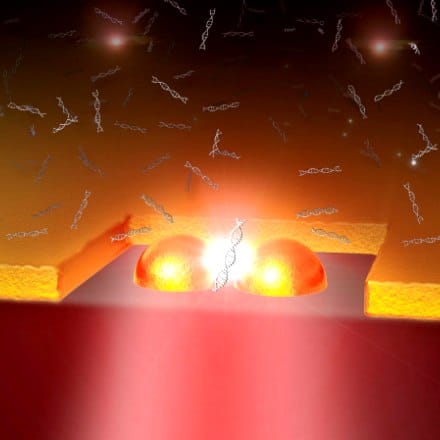
Good old fashioned boxes are here to stay, even in the context of nanoscale devices. Across a broad range of technologies and size regimes, boxes serve as containers for components, barriers against contaminants and/or radiation, and, as in the case of cell membranes, can be permeable to allow selected interactions between the interior and exterior. In a recent advance in optical detection, a nanoscale box-like housing was used to create an aperture that greatly enhanced the ability of antenna structures to detect single molecules at physiological concentrations. As reprinted at Phys.org:
Researchers at the Fresnel Institute in Marseille and ICFO-the Institute for Photonic Sciences in Barcelona report in Nature Nanotechnology the design and fabrication of the smallest optical device, capable of detecting and sensing individual biomolecules at concentrations that are similar to those found in the cellular context. The device called “antenna-in-a-box” consists of a tiny dimer antenna made out of two gold semi-spheres, separated from each other by a gap as small as 15nm. Light sent to this antenna is enormously amplified in the gap region where the actual detection of the biomolecule of interest occurs. Because amplification of the light is confined to the dimensions of the gap, only molecules present in this tiny region are detected. A second trick that the researchers used to make this device work was to embed the dimer antennas inside boxes also of nanometric dimensions. “The box screens out the unwanted “noise” of millions of other surrounding molecules, reducing the background and improving as a whole the detection of individual biomolecules.”, explains Jerome Wenger from Fresnel Institute. When tested under different sample concentrations, this novel antenna-in-box device allowed for 1100-fold fluorescence brightness enhancement together with detection volumes down to 58 zeptoliters (1 zL = 10-21L), i.e., the smallest observation volume in the world.
IFCO researcher and coauthor Maria Garcia-Parajo notes that the platform could also serve as a very bright, nanoscale light source.
Because the optical benefits come from the inner dimensions of the box (i.e. the aperture), the outer dimensions can vary, opening possibilities for customized sizes and shapes, as well as possible detection arrays.
-Posted by Stephanie C

